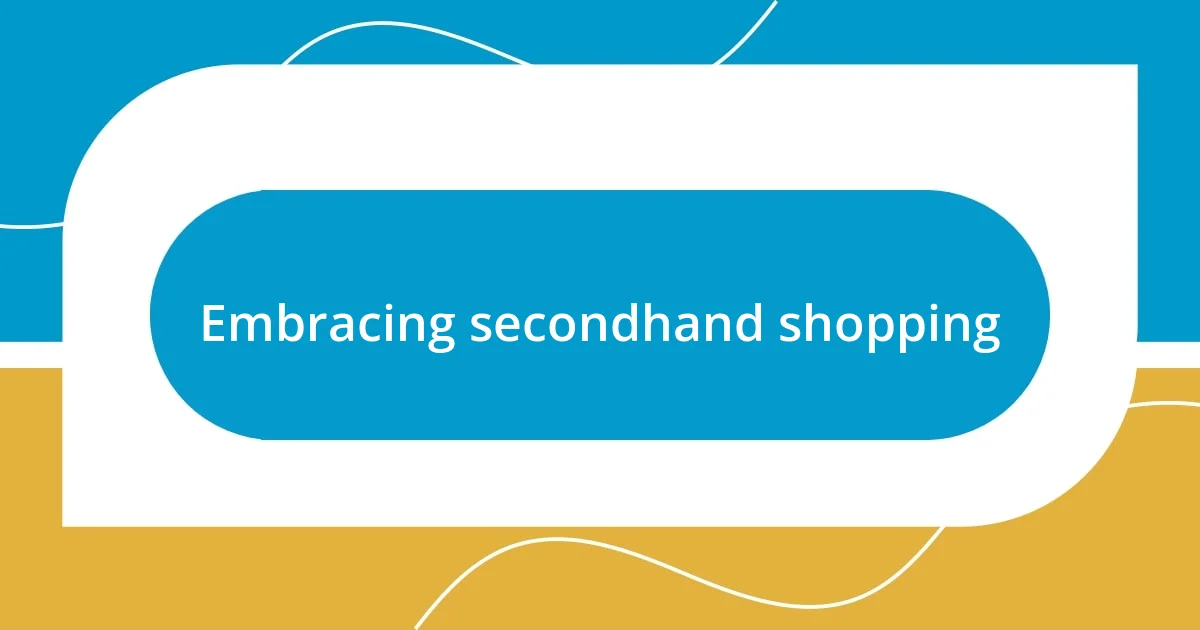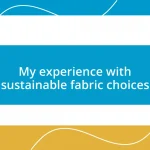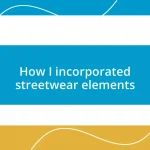Key takeaways:
- Fast fashion generates excessive waste and exploits garment workers, prompting a shift toward mindful consumption and sustainable practices.
- Embracing eco-friendly alternatives and secondhand shopping fosters a sense of creativity, community, and responsibility towards the environment.
- Sharing knowledge about sustainable fashion with others builds community engagement and encourages collective rethinking of shopping habits.

Understanding fast fashion issues
Fast fashion is not just about affordable clothes; it raises significant ethical and environmental dilemmas. I still remember the feeling of excitement when I bought a trendy piece for a fraction of the price, only to later realize the repercussions of those choices on our planet. How often do we stop to think about the sources of our clothing?
One glaring issue is the staggering amount of waste generated by the industry. The average consumer buys 60% more clothing today than they did 20 years ago but keeps each item for half as long. I’ve often found myself clearing out my closet, tossing aside things that once thrilled me, which made me ponder: does the thrill of a bargain truly outweigh the impact on landfills?
Moreover, the exploitation of garment workers in developing countries is a heartbreaking reality. I vividly recall hearing stories from friends who volunteered abroad, detailing the harsh conditions these workers face. It made me question my shopping habits deeply—am I, in my quest for style, inadvertently supporting a system that thrives on injustice?

Recognizing personal consumption habits
Recognizing my personal consumption habits has been truly eye-opening. I tend to gravitate towards the latest trends, often forgetting to reflect on whether I genuinely need another top or pair of shoes. It’s like being stuck in a cycle—buying, wearing, and then just discarding. I vividly recall a shopping spree where I filled my cart without a second thought, only to later feel a pang of guilt when I realized that some items still had tags attached. Does this scenario resonate with you?
As I started tracking my purchases, I noticed patterns emerge—clothes were often bought on impulse rather than necessity. I’ve had moments of embarrassment, realizing how many of these items barely saw the light of day in my wardrobe. It was a revelation to recognize that my consumption was driven more by the thrill of the hunt than by any actual need for those garments. Have you ever found yourself in a similar predicament?
I also found it useful to categorize my clothing into essentials, occasional, and impulse buys. This simple act allowed me to see the stark difference between what I actually wore regularly and what was simply taking up space. It became a valuable exercise in understanding the impact of consumption—both on my wallet and the environment. What categories would you discover in your closet?
| Consumption Habit | Realization |
|---|---|
| Impulse Buying | Leads to regret and excess |
| Tracking Purchases | Reveals patterns and needs |
| Categorizing Clothing | Highlights essentials vs. excess |

Evaluating eco-friendly alternatives
Evaluating eco-friendly alternatives has become a crucial step for me in navigating the fast fashion dilemma. I’ve started to embrace brands that prioritize sustainability and ethical production practices. One sunny afternoon, I stumbled upon a small boutique that sold clothes made entirely from recycled materials. The joy I felt picking out a striking top, knowing it had minimal environmental impact, was unlike anything I experienced shopping at mainstream stores.
When considering alternatives, I found it helpful to keep these factors in mind:
- Sourcing: Look for brands that use organic or recycled fabrics. This not only reduces waste but also lessens chemical use in production.
- Production practices: Prioritize companies that ensure fair labor practices, so that garment workers are treated ethically and compensated fairly.
- Transparency: Seek brands that openly share their supply chain processes. If they can’t tell you where their materials come from, it’s a red flag.
- Durability: Choose clothing that is designed to last. Investing in quality pieces means you’ll buy less over time, which is better for both your wallet and the planet.
- Secondhand options: Exploring thrift stores or online resale platforms can be exciting. Each item has a unique story and contributes to reducing waste.
The more I delved into this world, the more I felt my perspective on fashion shift. I remember feeling an immense sense of pride wearing an outfit that I knew was helping the environment. It transformed shopping from a mindless task to a conscious experience, making each purchase feel like a step toward positive change rather than a guilt-inducing splurge.

Building a sustainable wardrobe
Building a sustainable wardrobe often begins with curating a mindful selection of pieces that truly resonate with my personal style. I still recall the excitement of my first “capsule wardrobe” experiment, where I narrowed down my clothing to just a few essentials. Suddenly, my mornings became less chaotic, as I found joy in mixing and matching my favorite items, each with its own story. Have you ever thought about how simplifying your wardrobe could transform your day-to-day dressing?
One of the most profound lessons for me was understanding the importance of quality over quantity. I remember splurging on a high-quality coat that, despite its higher price tag, has served me for years. Each time I wear it, I’m reminded of the craftsmanship and thoughtful design behind it. It’s not just a coat; it’s an investment, too. Isn’t it rewarding to know that a piece can become a staple in your wardrobe for years and not just a fleeting trend?
Embracing versatility is key as well. I still vividly remember discovering a beautiful scarf that I could wear in multiple ways—around my neck in winter, as a head wrap in summer, or even as a bag accessory. This realization helped me see that a few multi-functional pieces can significantly enhance my wardrobe’s sustainability. Isn’t it incredible how one item can unlock various styles and uses? This mindset shift has propelled me to explore creative ways to wear what I already own, prioritizing sustainable choices and minimizing waste.

Embracing secondhand shopping
Embracing secondhand shopping has opened up a whole new world for me, filled with hidden gems and nostalgia. I remember stepping into my first thrift store—there were racks of clothing, each piece whispering stories of its previous life. It felt like a treasure hunt, where I could snag unique finds at a fraction of the cost while simultaneously reducing my carbon footprint. Have you ever sifted through vintage hats or floppy skirts, imagining the lives they’ve led?
What I love most about thrifting is the sense of community and connection it fosters. One afternoon, I struck up a conversation with a fellow shopper who shared her favorite vintage pieces and the thrill of finding items that perfectly reflect her style. It reminded me that secondhand shopping isn’t just about the clothes; it’s about creating a tapestry of experiences, memories, and inspiration from those who came before us. Isn’t it exciting to think about how your wardrobe can tell a story that isn’t solely your own?
Moreover, secondhand shopping has taught me the value of patience and creativity. I recall a time when I found a beautiful, slightly worn leather jacket that I instantly fell in love with. Sure, it needed some TLC, and I spent an afternoon cleaning and conditioning it, but the satisfaction of breathing new life into that piece was incredibly rewarding. It made me realize how refreshing it can be to embrace imperfections and transform them into something uniquely mine. Have you ever felt the rush of reinventing a vintage item and making it your own?

Incorporating minimalism in fashion
Incorporating minimalism in fashion has truly reshaped how I view my wardrobe. When I decided to streamline my collection, I was surprised by how liberating it felt. I remember holding onto a pair of shoes that never saw the light of day; finally letting them go was a breath of fresh air. Have you ever experienced that feeling of release when simplifying what you own?
What struck me the most was how minimalism encourages creativity. With fewer items at my disposal, I found myself experimenting more with layering and accessorizing. I still laugh at that one time I took a simple white shirt and created five different looks for a week—all with the same base piece! It pushed me to rethink what I truly loved and how I could express my individuality through timeless choices rather than fleeting trends. Isn’t it fascinating how limitations can spark innovation?
Minimalism has also helped me become intentional about my purchases. Each time I consider adding a new piece, I ask myself whether it adds real value or if it’s just a passing whim. I remember gravitating toward a gorgeous, hand-knit sweater, but I paused, reflecting on how it fits into my existing wardrobe. Opting to invest in pieces that truly resonate with my style has led to a more cohesive and, dare I say, elegant wardrobe overall. Have you thought about how mindful purchasing could change your fashion landscape?

Sharing knowledge with others
Sharing knowledge about sustainable fashion has become a natural part of my journey, and I find joy in discussing these ideas with friends and family. I often host casual get-togethers where we explore our favorite thrift finds or chat about conscious brands. I remember one evening, as we all gathered around with a charcuterie board and coffee, someone mentioned a brilliant eco-friendly clothing line we’d never heard of. It was exciting to see everyone’s eyes light up, sparking a genuine conversation about style choices and environmental responsibility.
Sometimes, I wonder if sharing my experiences encourages others to rethink their shopping habits. For instance, after a friend expressed frustration over her overflowing closet, I suggested a clothing swap among our circle. What surprised me was the excitement it generated! We spent an afternoon exchanging pieces we had grown tired of, and the atmosphere buzzed with laughter and fresh ideas. I realized that knowledge isn’t just a one-way street; it opens up opportunities for community engagement and shared solutions.
I’ve found that social media can also be an effective platform for sharing insights about ethical fashion. I often post photos of my thrifted outfits or promote local sustainable brands on my feed. One post led to a mini-discussion on eco-conscious choices among my followers, where people shared their own tips and experiences. I love how these conversations can ripple out, helping cultivate a community passionate about making better choices. Have you ever used your social media to inspire change? It’s a powerful way to connect and spark meaningful dialogue.














